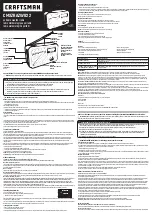
Page
3
WEATHER STATION SITE SELECTION:
Site selection for the Weather Station is
one of the most crucial steps in a
successful installation and an efficiently
operating irrigation system. The site
selection will greatly impact the
accuracy of the meteorological data
collected by the station. The site
selection process has many constraints
placed on it, and although the
“perfect”
site is often non-existent, the following
generalities should be kept in mind.
In general, the site should be
representative of the general area of
interest and reflect the general
conditions of the project’s turf. The
more “typical” the site, in this regard,
the more useful will be the information
gathered. The site should also be away
from the influence of obstructions such
as buildings, trees, etc.
The weather station should not be
located where sprinkler irrigation water
will strike sensors or instrument
enclosure. The turf around the weather
station needs to be irrigated however - so
it is recommended that half-circle
sprinklers be placed around the base of
the weather station and ”throwing OUT’
away from the weather station. In this
way the turf can be irrigated and at the
same time water can be kept off the
sensors and instrument enclosure of the
weather station.
The sensors of the weather station
should be eight (8) to ten (10) feet above
the turfgrass. Remember that the roof
of a building
IS NOT
a good site for the
weather station.
The weather station does NOT need to
be “hidden”. The Rain Bird weather
station has been engineered to be
aesthetically pleasing. The urge to
“hide” the station needs to be balanced
with the selection of the most “typical”
turfgrass area. The station should NOT
negatively impact the turfgrass
environment or utility. In fact, many
installations prominently display the
Weather Station to demonstrate their
commitment to water conservation.
If the site may be prone to vandalism,
an open, chain-link, 6 foot high
security fence with a lockable access
gate should be placed around the
weather station. The fence shall be a
minimum of eight (8) feet out from the
weather station on all sides and should
be a type that will not interfere with the
accuracy of the sensors.
In your selection of a site - try to avoid
sites on or near open dirt fields and
asphalt parking areas. These sites are
prone to high invective heats that can
distort the information. Any areas that
are within 90 to 100 feet “up wind” of
the weather station can adversely affect
the weather station reading accuracies.
The requirements of each weather
station sensor must be considered when
selecting the proper location for a
weather station site. In addition to these
generalities, each sensor has its own
specialized constraints. While complete
information is available, upon special
request, for each individual sensor, the
following are the highlights of each.
Summary of Contents for WS-PRO
Page 2: ......
Page 10: ...Page viii...
Page 16: ...Page 6 FIGURE 2 MAGNETIC DECLINATION FOR THE CONTIGUOUS UNITED STATE...
Page 21: ...Page 11 FIGURE 4 CONCRETE BASE DETAIL FIGURE 5 ANCHOR BOLT TEMPLATE DETAIL...
Page 24: ...Page 14 FIGURE 6 EXTERNAL WIRING DETAIL AT THE PRO SH WEATHER STATION...
Page 27: ...Page 17 FIGURE 7 EXTERNAL WIRING DETAIL AT THE PRO PH WEATHER STATION...
Page 33: ...Page 23 FIGURE 10 SOLAR PANEL INSTALLATION DETAIL...
Page 35: ...Page 25 FIGURE 11 CROSS ARM MOUNTING INSTALLATION OF 034A WIND SENSOR...
Page 48: ...Page 38 FIGURE 21 INSTALLATION AT CENTRAL COMPUTER FOR DIRECT CONNECTED WEATHER STATION...
Page 50: ...Page 40 FIGURE 22 INSTALLATION AT CENTRAL COMPUTER FOR TELEPHONE CONNECTED WEATHER STATION...
Page 73: ...Page 63 FIGURE 28 TYPICAL 3 ROD GROUNDING GRID DETAIL...
Page 75: ...Page 65 FIGURE 30 TESTING OF SOLAR RADIATION SENSOR...
Page 76: ...Page 66 FIGURE 31 TESTING OF RAIN GAGE...
Page 77: ...Page 67 FIGURE 32 TESTING OF TEMPERATURE RELATIVE HUMIDITY SENSOR...
Page 78: ...Page 68 FIGURE 33 TESTING OF AIR TEMPERATURE PROBE...













































